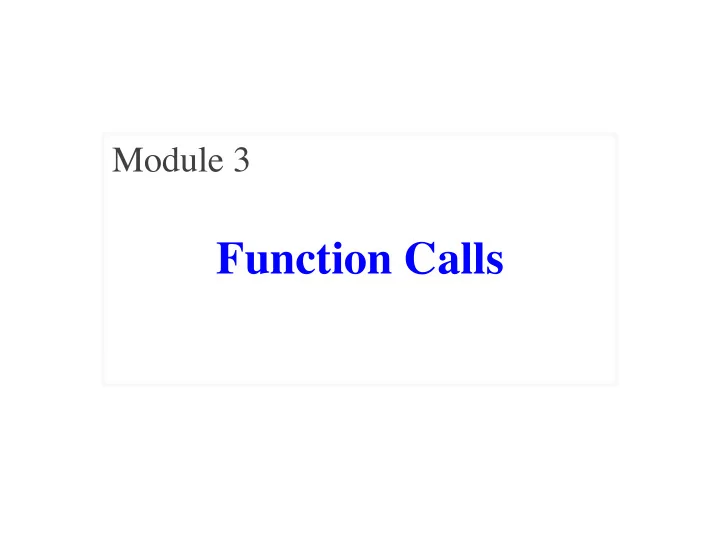

Module 3 Function Calls
Function Calls • Python supports expressions with math-like functions § A function in an expression is a function call • Function calls have the form name (x,y,…) function argument name § Arguments are themselves expressions § Arguments are separated by commas
Built-In Functions • Python has several math functions Arguments can be § round(2.34) any expression § max(a+3,24) • You have seen many functions already § Type casting functions: int() , float() , bool() • Documentation of all of these are online § https://docs.python.org/3/library/functions.html § Most of these are two advanced for us right now
Functions as Commands/Statements • Most functions are expressions. § You can use them in assignment statements § Example : x = round(2.34) • But some functions are commands . § They instruct Python to do something § Help function: help() These take no § Quit function: quit() arguments • How know which one? Read documentation.
Case Study: String Functions • String processing is a major feature of Python § Easier than in many other languages § Will be the focus of first major assignment • Also highlights the flexibility of functions § Many string functions are expressions § But some of the most important are commands • Let’s examine three important functions
Function len • Used as an expression § Value is # of chars in s § Evaluates to an int • Examples : § s = 'Hello' § len(s) == 5 Used in many § len('all') == 3 expressions § len(s+'all') == 8
Function print • Used as a command § Displays arguments on screen • Examples : § print('Hello') This is not a value! print should be Hello called by itself, not § x = print('Hello') is None in an expression § print('Hello\nWorld’) Hello Translates special characters World
One Last Function: input >>> input('Type something') Type somethingabc Like print but it 'abc' waits for typing >>> input('Type something: ') Type something: abc Evaluates to 'abc' what is typed >>> x = input('Type something: ') Type something: abc Can assign >>> x its value 'abc'
One Last Function: input >>> input('Type something') Type somethingabc Like print but it 'abc' waits for typing >>> input('Type something: ') Will see the purpose Type something: abc Evaluates to function of this later 'abc' what is typed >>> x = input('Type something: ') Type something: abc Can assign >>> x its value 'abc'
Built-in Functions vs Modules • The number of built-in functions is small § http://docs.python.org/3/library/functions.html • Missing a lot of functions you would expect § Example : cos() , sqrt() • Module : file that contains Python code § A way for Python to provide optional functions § To access a module, the import command
Example: Module math To access math >>> import math functions >>> cos(0) Traceback (most recent call last): File "<stdin>", line 1, in <module> NameError: name 'cos' is not defined >>> math.cos(0) Functions require math 1.0 prefix! >>> math.pi Module has 3.141592653589793 variables too! >>> math.cos(math.pi) -1.0
Example: Module math To access math >>> import math Other Modules functions >>> cos(0) Traceback (most recent call last): • io File "<stdin>", line 1, in <module> § Read/write from files • random NameError: name 'cos' is not defined § Generate random numbers >>> math.cos(0) Functions require math § Can pick any distribution 1.0 prefix! • string >>> math.pi Module has § Useful string functions 3.141592653589793 variables too! • sys >>> math.cos(math.pi) § Information about your OS -1.0
Reading Documentation • Being able to read docs is an important skill § It is impossible for you to memorize everything § If you need something, expected to look it up • Reason why programmers have large monitors § Can have documentation open at all times § Does not get in the way of programming • But reading documentation requires training § Information laid out in a very specific way § May not be obvious to a beginner
Reading the Python Documentation http://docs.python.org/library
Reading the Python Documentation Function name Possible arguments Module What the function evaluates to http://docs.python.org/library
Alternative: help() >>> import math help can take >>> help(math) an argument Help on module math: NAME Always available, but math not as searchable FUNCTIONS acos(...) acos(x) Return the arc cosine (measured in radians) of x. Hit space to : page through
Using the from Keyword >>> from math import * >>> import math Must prefix with >>> cos(0) >>> math.pi module name 1.0 3.141592653589793 >>> sin(0) >>> from math import pi No prefix needed 0.0 >>> pi for variable pi No prefix needed 3.141592653589793 for anything in math >>> cos(pi) ERROR ONLY imported pi
Be careful using from ! • Using import is safer § Modules might conflict (functions w/ same name) § What if import both? • Example : numpy § Has cos , sin too § Why? Performance (scientific computing) § But not always installed!
Renaming >>> import math as m >>> m.cos(0) Can rename a module 1.0 >>> from math import cos as fred >>> fred(0) Can rename 1.0 a function
Nested Modules Importing introcs >>> import introcs.strings imports all modules >>> introcs.strings.strip(' abc ') that it contains 'abc' >>> from introcs import strings >>> strings.strip(' abc ') 'abc' >>> from introcs.strings import strip >>> strip(' abc ')
Recommend
More recommend